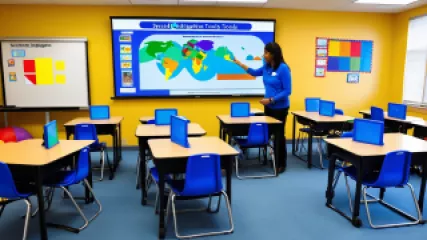6 Essential Special Education Tools to Improve Student Learning
6 Essential Special Education Tools to Improve Student Learning
As educators in the field of special education, we understand the unique challenges faced by students who require specialized support and tailored learning experiences. Providing the right tools and resources can make a significant difference in their academic and personal growth. In this comprehensive guide, we'll explore six essential special education tools that can dramatically improve student learning outcomes.
1. Interactive Visual Aids
Visual aids are a powerful tool in the special education classroom, as they cater to the diverse learning styles and needs of students. Interactive visual aids, such as interactive whiteboards, touchscreen displays, and multimedia presentations, can engage students and enhance their understanding of complex concepts.
These tools allow teachers to create dynamic, engaging lessons that incorporate visual elements, animations, and interactive components. By presenting information in a visually stimulating manner, students with various learning preferences, including those with visual or spatial processing difficulties, can better grasp and retain the material.
For example, an interactive whiteboard can be used to illustrate mathematical concepts, such as fractions or geometry, in a way that allows students to manipulate the visual elements and actively participate in the learning process. This hands-on approach can be particularly beneficial for students with cognitive or motor challenges, as it provides a more accessible and engaging way to learn.
2. Assistive Technology
Assistive technology (AT) refers to a wide range of tools and devices designed to support individuals with disabilities in their daily lives and educational pursuits. In the special education setting, assistive technology can be a game-changer, empowering students to overcome barriers and access learning materials more effectively.
Assistive technology can include devices such as text-to-speech software, digital reading pens, communication boards, and specialized input devices (e.g., touchscreens, eye-tracking systems). These tools can help students with learning disabilities, physical impairments, or communication difficulties to participate more actively in the classroom, complete assignments, and express their ideas and understanding.
For instance, a student with dyslexia might use text-to-speech software to have written materials read aloud, enabling them to focus on comprehending the content rather than struggling with decoding. Alternatively, a student with limited fine motor skills could use a specialized keyboard or mouse to more easily navigate their digital learning environment.
Integrating assistive technology into the special education curriculum not only supports individual student needs but also fosters independence, confidence, and a sense of empowerment among learners.
3. Sensory Integration Tools
Sensory integration tools are designed to address the unique sensory processing needs of students, particularly those with autism spectrum disorder (ASD), attention-deficit/hyperactivity disorder (ADHD), or other neurological conditions. These tools can help regulate a student's sensory input, reducing anxiety, improving focus, and creating a more conducive learning environment.
Sensory integration tools can include weighted blankets or vests, fidget toys, calming music, or specialized seating options. By providing students with the means to self-regulate their sensory experiences, these tools can help them better engage with the learning material and participate in classroom activities.
For example, a student with ADHD might use a weighted lap pad or a stress ball to help them stay focused during lessons. Alternatively, a student with ASD might use noise-cancelling headphones to minimize auditory distractions and create a more comfortable learning space.
Incorporating sensory integration tools into the special education classroom demonstrates a comprehensive understanding of the diverse needs of students and a commitment to creating an inclusive, supportive learning environment.
4. Structured Learning Environments
Structured learning environments are an essential component of effective special education programs. These environments provide clear routines, predictable schedules, and well-defined expectations, which can significantly benefit students with various learning needs, including those with autism, ADHD, or intellectual disabilities.
Structured learning environments can involve the use of visual schedules, task analysis, and organizational systems to help students understand the flow of the day and anticipate upcoming activities. This predictability can reduce anxiety, improve on-task behavior, and foster a sense of independence and self-regulation among students.
For instance, a student with autism might use a visual schedule to understand the sequence of their day, from arrival to dismissal. This can help them transition smoothly between activities and reduce the stress associated with unexpected changes in their routine.
Additionally, structured learning environments often incorporate the use of designated work areas, clear work expectations, and visual supports to help students stay focused and engaged throughout the learning process.
5. Personalized Learning Pathways
Personalized learning pathways are a crucial element in special education, as they recognize that each student has unique strengths, needs, and learning styles. By tailoring the curriculum, instructional strategies, and assessment methods to the individual student, educators can optimize their learning experiences and support their academic and personal growth.
Personalized learning pathways may involve the use of differentiated instruction, adaptive learning software, or individualized education plans (IEPs) to ensure that the content, pacing, and teaching methods align with the student's specific requirements. This approach allows students to progress at their own pace, focus on areas of difficulty, and build upon their existing knowledge and skills.
For example, a student with a learning disability in mathematics might use an adaptive learning program that continuously adjusts the level of difficulty based on their performance, providing targeted support and challenging them appropriately. Alternatively, a student with a physical disability might have an IEP that outlines the use of assistive technology, modified assignments, and alternative assessment methods to accommodate their needs.
By embracing personalized learning pathways, special education teachers can create a more inclusive and empowering learning environment that empowers students to achieve their full potential.
6. Collaborative Learning Opportunities
Collaborative learning opportunities are essential in special education, as they foster social skills, communication, and teamwork among students. By engaging in group-based activities, students with diverse learning needs can learn from their peers, develop social-emotional skills, and experience a sense of belonging within the school community.
Collaborative learning opportunities can take various forms, such as small-group projects, peer-assisted learning, or inclusive extracurricular activities. These experiences allow students to work together, share ideas, and support one another in a structured and supportive environment.
For instance, a group of students with varying abilities might work together on a science fair project, where they can contribute their unique skills and perspectives to the final product. This not only reinforces academic content but also promotes social interaction, problem-solving, and conflict resolution skills.
Alternatively, a peer-assisted learning program might pair a student with a learning disability with a classmate who can provide tutoring, mentorship, and social support, fostering a sense of community and mutual understanding.
By incorporating collaborative learning opportunities into the special education curriculum, educators can create a more inclusive and enriching learning environment that prepares students for success in both academic and social settings.
Conclusion
In the ever-evolving field of special education, the effective use of specialized tools and resources can dramatically improve student learning outcomes. From interactive visual aids and assistive technology to sensory integration tools and personalized learning pathways, each of the six essential elements discussed in this guide plays a crucial role in supporting the diverse needs of students with various learning challenges.
By embracing these tools and strategies, special education teachers can create a more inclusive, engaging, and empowering learning environment that empowers students to reach their full potential. As we continue to explore and innovate within the field of special education, the integration of these essential tools will undoubtedly be a driving force in enhancing the educational experiences and lifelong success of our students.
Remember, the key to effectively implementing these special education tools is to tailor them to the unique needs and learning styles of each individual student. By taking a comprehensive, student-centered approach, educators can ensure that their students receive the personalized support and resources they need to thrive academically, socially, and emotionally.
As you continue your journey in special education, we encourage you to explore and experiment with these essential tools, always keeping the best interests of your students at the forefront of your practice. With dedication, creativity, and a deep commitment to inclusive education, you can make a lasting difference in the lives of the students you serve.






